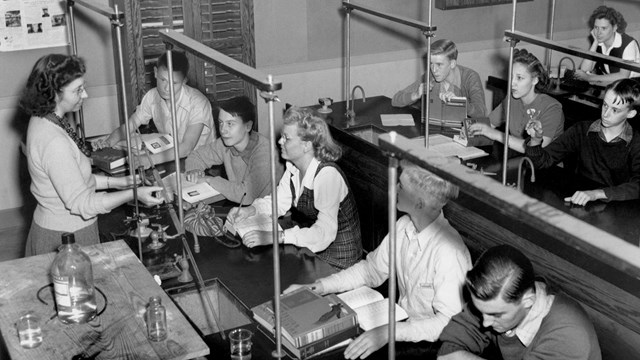Science Labs, Student Activities, Other Education Materials
- Grade Level:
- High School: Ninth Grade through Twelfth Grade
- Subject:
- Science
- Common Core Standards:
- 9-10.RST.3, 9-10.RST.4, 9-10.RST.5, 9-10.RST.6, 9-10.RST.7, 9-10.RST.8, 9-10.RST.9, 9-10.RST.10, 11-12.RST.3, 11-12.RST.4, 11-12.RST.5, 11-12.RST.6, 11-12.RST.7, 11-12.RST.8, 11-12.RST.9, 11-12.RST.10
- State Standards:
- HS-PS1-8

US DEPARTMENT OF ENERGY/ED WESTCOTT
Objective
This set of lessons is intended to introduce students to basic nuclear chemistry concepts through lessons linked to the Manhattan Project. This lesson series includes hands-on lessons for those willing to acquire the equipment, but also videos and data for use without a Geiger counter or other listed equipment.
Background
Scientists in Germany discovered fission in December 1938. Hungarian physicist Leo Szilard realized that nuclear chain reactions could be used to create new and extremely powerful atomic weapons. In August 1939, Szilard wrote a letter for Albert Einstein to sign and send to President Franklin D. Roosevelt warning that an "extremely powerful bomb" might be constructed. Fearing ongoing research and development by Nazi Germany, Roosevelt formed the Advisory Committee on Uranium, which met for the first time on October 21, 1939.
The United States formally entered World War II after Imperial Japan bombed Pearl Harbor on December 7, 1941. With the US now at war, the Advisory Committee on Uranium concluded that an atomic bomb could be designed, built, and used in time to influence the outcome of the war. To accomplish this task, the Army Corps of Engineers established the Manhattan Engineer District, headed by Brigadier General Leslie Groves, in Manhattan, New York. This focused effort combined military, scientific, and industrial resources. The Manhattan Project largely remained secret even though it involved hundreds of thousands of workers across the country.
Scientists theorized there were two potential paths to building an atomic bomb. One path would use the uranium 235 isotope, which comprises on average less than one percent of naturally occurring uranium. The other would use the newly discovered element plutonium, which could be produced in a nuclear reactor using uranium fuel. Both paths required the use of expensive and unproven processes, and success was by no means guaranteed. As a result, the decision was made to move forward with both paths and establish three main sites to support the project. The project would also involve numerous smaller sites around the nation and the world.
Procedure
Explore the lesson plan and use all or some of it to enhance your classroom experience.
Assessment Materials
Included in the lesson plan is a culminating project to create a research poster. See the Sample Rubric listed under Materials below for suggested grading standards.
Additional Resources
Scientists and Engineers of the Manhattan Project
Contact Information
Email us about this lesson plan
Materials
Three- to four-week lesson plan for Nuclear Chemistry relating to the Manhattan Project.
Download Nuclear Chemistry Lesson Plan
Sample slides to introduce isotopes.
Sample rubric for grading the research poster project.
Additional historical context connecting the science to the scientists of the Manhattan Project.
Last updated: May 8, 2024
